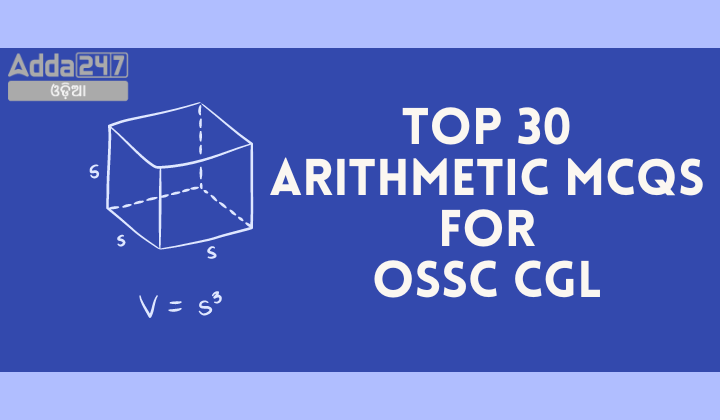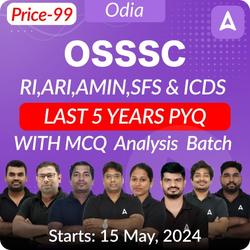Are you preparing for the Odisha Staff Selection Commission Combined Graduate Level (OSSC CGL) examination and seeking comprehensive practice material? Mastering arithmetic is crucial as it forms a significant portion of the syllabus. To aid in your preparation, we’ve curated a set of 30 multiple-choice questions covering various arithmetic topics commonly tested in the OSSC CGL exam. Let’s dive into these questions to strengthen your arithmetic skills and boost your confidence for the upcoming examination.
Top 30 Arithmetic MCQs For OSSC CGL
1. A boat can travel with a speed of 13 km/hr in still water. If the speed of the stream is 4 km/hr, find the time taken by the boat to go 68 km downstream.
A. 2 hours
B. 3 hours
C. 4 hours
D. 5 hours
Answer: Option C
Explanation: Speed downstream = (13 + 4) km/hr = 17 km/hr.
Time taken to travel 68 km downstream = 68/17 hrs = 4 hrs.
2. A man’s speed with the current is 15 km/hr and the speed of the current is 2.5 km/hr. The man’s speed against the current is:
A. 8.5 km/hr
B. 9 km/hr
C. 10 km/hr
D. 12.5 km/hr
Answer: Option C
Explanation: Man’s rate in still water = (15 – 2.5) km/hr = 12.5 km/hr.
Man’s rate against the current = (12.5 – 2.5) km/hr = 10 km/hr.
3. A boat running upstream takes 8 hours 48 minutes to cover a certain distance, while it takes 4 hours to cover the same distance running downstream. What is the ratio between the speed of the boat and speed of the water current respectively?
A. 2 : 1
B. 3 : 2
C. 8 : 3
D. Cannot be determined
Answer: Option C
Explanation: Let the man’s rate upstream be x kmph and that downstream be y kmph.
Then, distance covered upstream in 8 hrs 48 min = Distance covered downstream in 4 hrs.
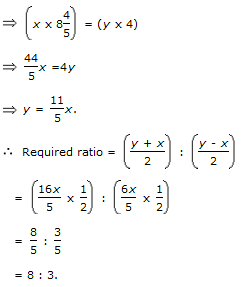
4. A motorboat, whose speed in 15 km/hr in still water goes 30 km downstream and comes back in a total of 4 hours 30 minutes. The speed of the stream (in km/hr) is:
A. 4
B. 5
C. 6
D. 10
Answer: Option B
Explanation: Let the speed of the stream be x km/hr. Then,
Speed downstream = (15 + x) km/hr,
Speed upstream = (15 – x) km/hr.
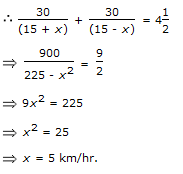
5. In one hour, a boat goes 11 km/hr along the stream and 5 km/hr against the stream. The speed of the boat in still water (in km/hr) is:
A. 3 km/hr
B. 5 km/hr
C. 8 km/hr
D. 9 km/hr
Answer: Option C
Explanation: Speed in still water = 1/2x(11 + 5) kmph = 8 kmph.
6. A boat running downstream covers a distance of 16 km in 2 hours while for covering the same distance upstream, it takes 4 hours. What is the speed of the boat in still water?
A. 4 km/hr
B. 6 km/hr
C. 8 km/hr
D. Data inadequate
Answer: B
Explanation: Rate downstream = 16/2 kmph = 8 kmph. Rate upstream = 16/4 kmph = 4 kmph. Speed in still water = 1/2 × (8 + 4) kmph = 6 kmph.
7. The speed of a boat in still water is 15 km/hr and the rate of current is 3 km/hr. The distance traveled downstream in 12 minutes is:
A. 1.2 km
B. 1.8 km
C. 2.4 km
D. 3.6 km
Answer: D
Explanation: Speed downstream = (15 + 3) kmph = 18 kmph. Distance traveled = 18 × (12/60) km = 3.6 km.
8. A boat takes 90 minutes less to travel 36 miles downstream than to travel the same distance upstream. If the speed of the boat in still water is 10 mph, the speed of the stream is:
A. 2 mph
B. 2.5 mph
C. 3 mph
D. 4 mph
Answer: A
Explanation: Let the speed of the stream be x mph. Then, downstream speed = (10 + x) mph, upstream speed = (10 – x) mph. Solving the equation, we find x = 2 mph.
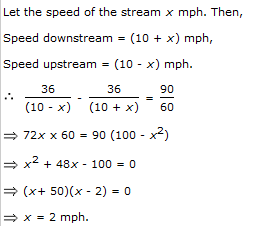
9. A man can row at 5 kmph in still water. If the velocity of the current is 1 kmph and it takes him 1 hour to row to a place and come back, how far is the place?
A. 2.4 km
B. 2.5 km
C. 3 km
D. 3.6 km
Answer: A
Explanation: Let the required distance be x km. Then, x/6 + x/4 = 1. Solving, we find x = 2.4 km.
10. A boat covers a certain distance downstream in 1 hour, while it comes back in 1 hours. If the speed of the stream be 3 kmph, what is the speed of the boat in still water?
A. 12 kmph
B. 13 kmph
C. 14 kmph
D. 15 kmph
Answer: D
Explanation: Let the speed of the boat in still water be x kmph. Then, solving the equation, we find x = 15 kmph.
11. A boatman goes 2 km against the current of the stream in 1 hour and goes 1 km along the current in 10 minutes. How long will it take to go 5 km in stationary water?
A. 40 minutes
B. 1 hour
C. 1 hr 15 min
D. 1 hr 30 min
Answer: C
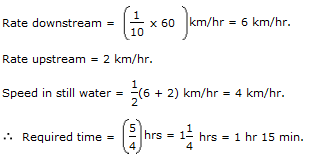
12. A man can row three-quarters of a kilometre against the stream in 11 1/4 minutes and down the stream in 7 1/2 minutes. The speed (in km/hr) of the man in still water is:
A. 2
B. 3
C. 4
D. 5
Answer: D
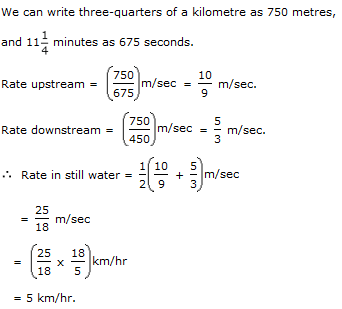
13. Speed of a boat in standing water is 9 kmph and the speed of the stream is 1.5 kmph. A man rows to a place at a distance of 105 km and comes back to the starting point. The total time taken by him is:
A. 16 hours
B. 18 hours
C. 20 hours
D. 24 hours
Answer: D
Explanation: Speed upstream = 7.5 kmph. Speed downstream = 10.5 kmph. Total time taken = 105/7.5 + 105/10.5 hours = 24 hours.
14. A man takes twice as long to row a distance against the stream as to row the same distance in favour of the stream. The ratio of the speed of the boat (in still water) and the stream is:
A. 2 : 1
B. 3 : 1
C. 3 : 2
D. 4 : 3
Answer: B
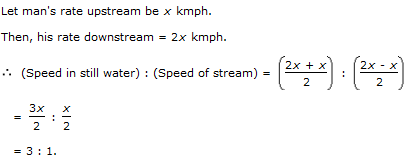
15. A man rows to a place 48 km distant and come back in 14 hours. He finds that he can row 4 km with the stream in the same time as 3 km against the stream. The rate of the stream is:
A. 1 km/hr
B. 1.5 km/hr
C. 2 km/hr
D. 2.5 km/hr
Answer: A
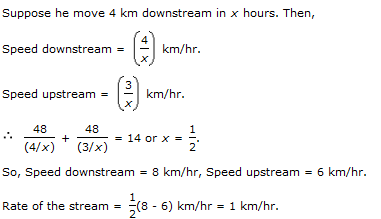
16. What is the principal sum if the simple interest amounts to 815 in 3 years and $854 in 4 years?
A. 650
B. 690
C. 698
D. 700
Answer: C. 698
Explanation: S.I. for 1 year = (854 – 815) = 39.
S.I. for 3 years = (39 x 3) = 117.
Principal = (815 – 117) = 698.
17. Mr. Thomas invested a total of 13,900 in two different schemes A and B at the simple interest rates of 14% p.a. and 11% p.a. respectively. If the total amount of simple interest earned in 2 years is 3508, how much was invested in Scheme B?
A. 6400
B. 6500
C. 7200
D. 7500
Answer: A. 6400
Explanation:
Let the sum invested in Scheme A be x and that in Scheme B be (13900 – x).
Then, (x x 14 x 2)/100 + ((13900 – x) x 11 x 2)/100 = 3508
28x – 22x = 350800 – (13900 x 22)
6x = 45000
x = 7500.
So, sum invested in Scheme B = (13900 – 7500) = 6400.
18. If a sum of money earns a total simple interest of 4016.25 at a rate of 9% p.a. in 5 years, what is the principal sum?
A. 4462.50
B. 8032.50
C. 8925
D. None of these
Answer: C. 8925
Explanation:
Principal = (100 x 4016.25)/(9 x 5)
= 401625/45
= 8925.
19. The cube root of .000216 is:
A. .6
B. .06
C. 77
D. 87
Answer: Option B
Explanation:
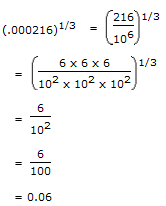
20. √1.5625 = ?
A. 1.05
B. 1.25
C. 1.45
D. 1.55
Answer: Option B
Explanation: By using your calculator you get the answer 1.25 = B.
21. The least perfect square, which is divisible by each of 21, 36 and 66 is:
A. 213444
B. 214344
C. 214434
D. 231444
Answer: Option A
Explanation:

22. Look at this series: 2, 1, (1/2), (1/4), … What number should come next?
A. (1/3)
B. (1/8)
C. (2/8)
D. (1/16)
Answer: Option B
Explanation: This is a simple division series; each number is one-half of the previous number. In other terms to say, the number is divided by 2 successively to get the next result.
4/2 = 2
2/2 = 1
1/2 = 1/2
(1/2)/2 = 1/4
(1/4)/2 = 1/8 and so on.
23. Look at this series: 7, 10, 8, 11, 9, 12, … What number should come next?
A. 7
B. 10
C. 12
D. 13
Answer: Option B
Explanation: This is a simple alternating addition and subtraction series. In the first pattern, 3 is added; in the second, 2 is subtracted.
24. Look at this series: 36, 34, 30, 28, 24, … What number should come next?
A. 20
B. 22
C. 23
D. 26
Answer: Option B
Explanation: This is an alternating number subtraction series. First, 2 is subtracted, then 4, then 2, and so on.
25. Two students appeared at an examination. One of them secured 9 marks more than the other and his marks was 56% of the sum of their marks. The marks obtained by them are:
A. 39, 30
B. 41, 32
C. 42, 33
D. 43, 34
Answer: Option C
Explanation: Let their marks be (x + 9) and x.
Then, x + 9 = 56/100(x + 9 + x)
25(x + 9) = 14(2x + 9)
3x = 99
x = 33
So, their marks are 42 and 33.
26. A fruit seller had some apples. He sells 40% apples and still has 420 apples. Originally, he had:
A. 588 apples
B. 600 apples
C. 672 apples
D. 700 apples
Answer: Option D
Explanation: Suppose originally he had x apples.
Then, (100 – 40)% of x = 420.
60/100 x x = 420
x = (420 x 100)/60 = 700.
27. What percentage of numbers from 1 to 70 have 1 or 9 in the unit’s digit?
A. 1
B. 14
C. 20
D. 21
Answer: Option C
Explanation: Clearly, the numbers which have 1 or 9 in the unit’s digit, have squares that end in the digit 1.
Such numbers from 1 to 70 are 1, 9, 11, 19, 21, 29, 31, 39, 41, 49, 51, 59, 61, 69.
Number of such number =14
Required percentage = (14/70 x 100)% = 20%.
28. A person crosses a 600 m long street in 5 minutes. What is his speed in km per hour?
A. 3.6
B. 7.2
C. 8.4
D. 10
Answer: Option B
Explanation:
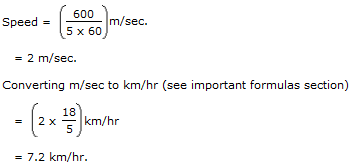
29. An aeroplane covers a certain distance at a speed of 240 kmph in 5 hours. To cover the same distance in 1 2/3 hours, it must travel at a speed of:
A. 300 kmph
B. 360 kmph
C. 600 kmph
D. 720 kmph
Answer: Option D
Explanation: Distance = (240 x 5) = 1200 km.
Speed = Distance/Time
Speed = 1200/(5/3) km/hr. [We can write 1 2/3 hours as 5/3 hours]
Required speed = 1200 x 3/5 km/hr = 720 km/hr.
30. If a person walks at 14 km/hr instead of 10 km/hr, he would have walked 20 km more. The actual distance travelled by him is:
A. 50 km
B. 56 km
C. 70 km
D. 80 km
Answer: Option A
Explanation: Let the actual distance travelled be x km.
Then, x/10 = (x + 20)/14
14x = 10x + 200
4x = 200
x = 50 km

